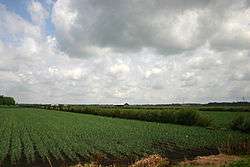Sapric
In the World Reference Base for Soil Resources and similar soil classification systems, a sapric is a subtype of a histosol where virtually all of the organic material has undergone sufficient decomposition to prevent the identification of plant parts.[1][2] Muck is a sapric soil that is naturally waterlogged or is artificially drained.
| Sapric | |
|---|---|
| |
| Used in | WRB, USDA soil taxonomy, others |
| WRB code | sa, HSsa |
| Parent material | Organic matter |
Classification
The soils are deep, dark colored, and friable, often underlain by marl, or marly clay.
World Reference Base
The World Reference Base for Soil Resources (WRB) defines "sapric" (sa) as a histosol having less than one-sixth (by volume) of the organic material consisting of recognizable plant tissue within 100 cm of the soil surface.[3]
Canada
Muck soils fall under the Organic Order in the Canadian system of soil classification.[4] Muck soils are organic soils, with at minimum of 30% organic matter and a depth of at least 40 cm.[4]
United States
In the USDA soil taxonomy, sapric may be a subtype of a haplohemist or glacistel type, and may also be a diagnostic organic soil material where the fiber content is less than one-sixth of the volume.[1] Muck soils are defined by the USDA NRCS as sapric organic soils that are saturated more than 30 cumulative days in normal years or are artificially drained.[5] In other words, it is a soil made up primarily of humus from drained swampland.
Use and vegetation

Muck soil is used for growing specialty crops such as onions, carrots, celery, and potatoes.
Geography
Muck farming on drained swamps is an important part of agriculture in New York, Ohio, Illinois, Indiana, Michigan, Wisconsin, and Florida, where mostly vegetables are grown. The muckland of Torrey Farms of Elba, New York, which covers the counties of Orleans, Niagara, and Genesee, is thought to be the largest continuous section of muckland in the world.[6] American "muckers" often have roots from the Netherlands or Eastern Europe, where their ancestors practiced a similar type of farming. Holland Marsh, north of Toronto, Ontario, is the site of the Muck Crops Research Station, a part of the University of Guelph.
Conservation
Muck farming is controversial, because the drainage of wetlands destroys wildlife habitats and results in a variety of environmental problems. It is unlikely that any more will be created in the United States, because of environmental regulations. It is prone to problems. As the soil is very light, windbreaks are necessary to protect these fields in dry weather. It also can catch fire and burn underground for months. Oxidation also removes a portion of the soil each year, so it becomes progressively shallower. Oxidation also discharges carbon dioxide. Some muck land has been reclaimed and restored as wetlands for wildlife preserves.
The impacts of drainage and agricultural production cause the loss of organic matter in muck soils through erosion, oxidation, and other processes collectively referred to as "subsidence." Agricultural practices such as cover cropping and reduced tillage can significantly reduce subsidence, but can not reverse it. Muck soils are in essence a non-renewable agricultural resource.[7]
Etymology
The word muck has much usage in the English language, referring in some cases to agricultural soil, and in others to dirt in general, and animal dung in particular. Origins are probably from Norse, Danish, and Proto-Germanic roots referring to cow dung.[8][9]
See also
References
- Canarache, A.; Vintila, I.I.; Munteanu, I. (2006). Elsevier's Dictionary of Soil Science. Elsevier. p. 745. ISBN 9780080561318.
- Field Indicators of Hydric Soils in the United States: A Guide for Identifying and Delineating Hydric Soils (version 8.1 ed.). Natural Resources Conservation Service. 2017. p. 38. Archived from the original on 2017-05-24.
- IUSS Working Group WRB (2015). World Reference Base for Soil Resources 2014, update 2015 (PDF). International soil classification system for naming soils and creating legends for soil maps. World Soil Resources Reports No. 106. Rome: FAO. ISBN 978-92-5-108370-3. Archived (PDF) from the original on 2016-12-13.
- Canada Soil Survey Committee, Subcommittee on soil classification (1978). "The Canadian system of soil classification". Can. Dep. Agric. Publ. 1646. Supply and Services Canada (Pb), Ottawa, Ontario. 83pp.
- Field Book for Describing and Sampling Soils (version 3.0 ed.). Natural Resources Conservation Service. 2012. p. 2–43. Archived from the original on 2017-05-01.
- "Archived copy". Archived from the original on 2009-04-17. Retrieved 2009-06-01.CS1 maint: archived copy as title (link)
- Conservation of Muck Soils in New York. Agronomy Fact Sheet Series, Cornell Cooperative Extension. Accessed 7/13/20. http://nmsp.cals.cornell.edu/publications/factsheets/factsheet86.pdf
- "Online Etymology Dictionary". etymonline.com. Archived from the original on 11 July 2015. Retrieved 10 July 2015.
- "Muck - Definition of muck by Merriam-Webster". merriam-webster.com. Archived from the original on 11 July 2015. Retrieved 10 July 2015.
External links
- Barbagallo, Tricia (June 1, 2005). "Black Beach: The Mucklands of Canastota, New York" (PDF). Archived from the original (PDF) on November 13, 2013. Retrieved 2013-04-22.
- The Horicon National Wildlife Refuge, established on muck land returned as much as possible to the original state
- An example of a typical muck farming operation